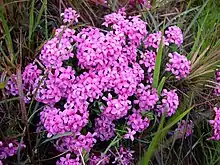Daphne cneorum
Daphne cneorum, the garland flower or rose daphne, is a species of flowering plant in the family Thymelaeaceae, native to the mountains of central and southern Europe. It is a prostrate spreading evergreen shrub to 20 cm (8 in), grown for its dense clusters of highly fragrant pink flowers in spring.[2][3][4] All parts of the plant are poisonous to humans.[5] In cultivation it requires a sheltered position in full sun or partial shade. It is not completely hardy in exposed locations.
| Daphne cneorum | |
|---|---|
 | |
| Scientific classification | |
| Kingdom: | Plantae |
| Clade: | Tracheophytes |
| Clade: | Angiosperms |
| Clade: | Eudicots |
| Clade: | Rosids |
| Order: | Malvales |
| Family: | Thymelaeaceae |
| Genus: | Daphne |
| Species: | D. cneorum |
| Binomial name | |
| Daphne cneorum | |
| Synonyms[1] | |
| |
The Latin specific epithet cneorum comes from the Greek and means “like a small olive bush”.[6]
The vigorous cultivar 'Eximia' has gained the Royal Horticultural Society's Award of Garden Merit.[7]
.JPG.webp)
Pests and diseases
In plant nurseries rose daphnes can be affected by various diseases. One of them is caused by Thielaviopsis basicola and named daphne sudden death syndrome (DSDS). In this disease the plants get black lesions along the roots and then in the two weeks after developing foliar symptoms they die.[8]
References
- "Daphne cneorum". The Plant List. Retrieved 2017-11-17.
- "Daphne cneorum". University of Delaware Botanic Gardens. Archived from the original on 28 September 2011. Retrieved 26 May 2011.
- "Rose Daphne". Winnipeg, Manitoba: Shelmerdine Garden Center. Retrieved 26 May 2011.
- RHS A-Z encyclopedia of garden plants. United Kingdom: Dorling Kindersley. 2008. p. 1136. ISBN 978-1405332965.
- "Daphne cneorum". RHS. Retrieved 7 May 2019.
- Harrison, Lorraine (2012). RHS Latin for Gardeners. United Kingdom: Mitchell Beazley. ISBN 978-1845337315.
- "Daphne cneorum 'Eximia'". Royal Horticultural Society. Retrieved 25 May 2020.
- Noshad, D.; Riseman, A.; Punja, Z. K. (June 2006). "First report of Thielaviopsis basicol a on Daphne cneorum". Canadian Journal of Plant Pathology. 28 (2): 310–312. doi:10.1080/07060660609507300. eISSN 1715-2992. ISSN 0706-0661.